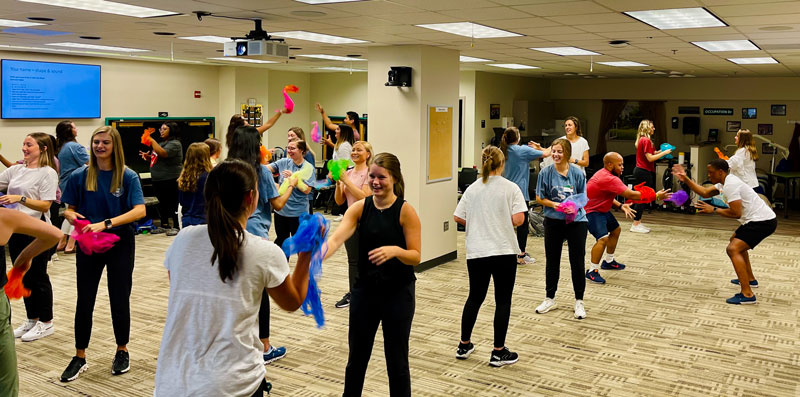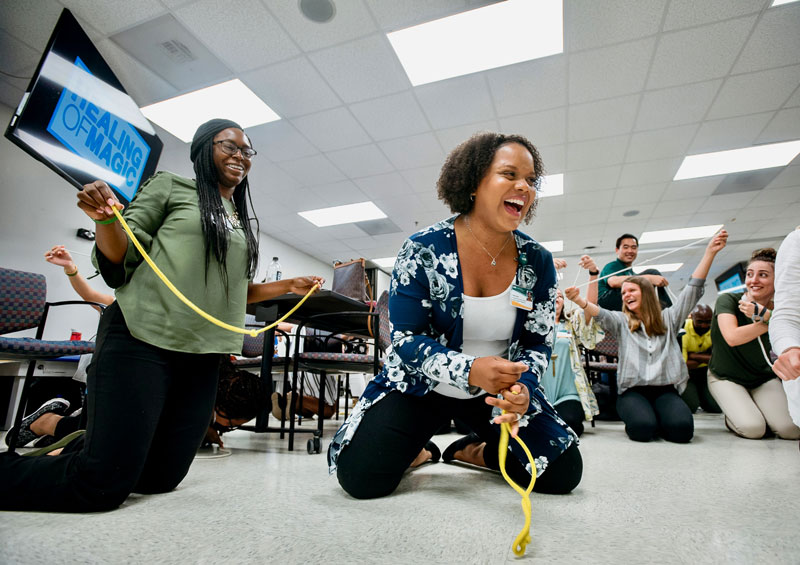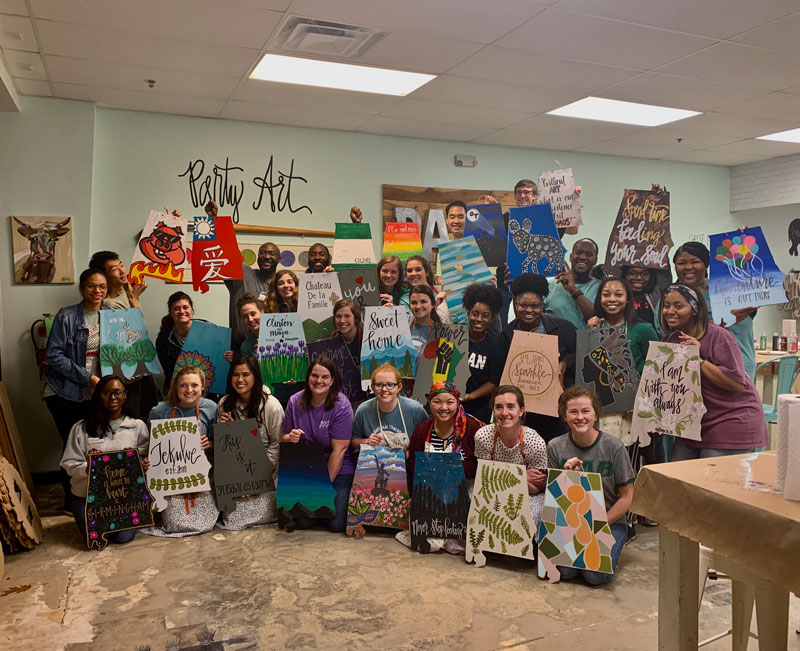Creative occupations: Joyful class introduces students to art as a powerful therapeutic tool
 Students feel the joy of creative expression through dance and movement. Each Friday afternoon of their first summer semester, UAB’s entry-level OTD students explore the world of artistic expression in creative occupations class. Many students look forward all week to this course, in which professional artists guide them through first-hand experiences in an array of artistic mediums.
Students feel the joy of creative expression through dance and movement. Each Friday afternoon of their first summer semester, UAB’s entry-level OTD students explore the world of artistic expression in creative occupations class. Many students look forward all week to this course, in which professional artists guide them through first-hand experiences in an array of artistic mediums.
Second-year OTD student Anna Livingston says the class deepened her passion for occupational therapy (OT).
“Creative occupations showed me what sets occupational therapy apart from other healthcare professions and truly reminded me why I want to be an OT,” she says. “As OTs, we can see all the various cognitive, physical, and emotional benefits of creative occupations such as music, art, and movement.”
UAB Department of Occupational Therapy Chair Gavin Jenkins, PhD, OTR/L, ATP, who is course director for the class, notes that arts and creativity are central to our humanity.
“They provide an outlet for expression, connection, meaning-making, and catharsis,” he says, noting the OT profession has integrated art into therapy since its inception in the early 1900s, when therapists first used creative expression to help people with mental health conditions.
‘Art is an access.’
The Department of Occupational Therapy partners with UAB Arts in Medicine (AIM) to bring this course to students, who gain hands-on experience with the healing power of art. AIM’s artists in residence, who work in hospitals and the community to enhance well-being and healing through creative arts experiences, lead the sessions.
For OT students, these artists open a door into the potential of their different mediums, which include visual arts, dance and movement, music, expressive writing, poetry, storytelling, magic, and theater, as therapeutic tools. Students discuss the intersection of OT and these mediums, and then write, paint, draw, act, dance, and more in active exploration.
 OT students learn magic tricks, which they’ll teach to children with disabilities in the department’s annual Magic Camp. Learning to perform the tricks helps children gain dexterity, confidence and motivation, and better emotional and social function. Rather than tying creative expression to precise elements of occupational therapy, the artists seek to merge their work with its philosophy and spirit, says AIM Director Kimberly Kirklin, MA.
OT students learn magic tricks, which they’ll teach to children with disabilities in the department’s annual Magic Camp. Learning to perform the tricks helps children gain dexterity, confidence and motivation, and better emotional and social function. Rather than tying creative expression to precise elements of occupational therapy, the artists seek to merge their work with its philosophy and spirit, says AIM Director Kimberly Kirklin, MA.
“We align with OT students through our shared goal of enhancing the health and wellness of the people we serve, and hope they leave class with a sense of how they can incorporate art into therapeutic practice,” she says. “Basically, we come from our place, meet them where they are, and move forward with how the arts can support what they want to do for their clients.”
Visual artist Helene Taylor, who has been an AIM artist in residence since 2013, has seen the countless ways art enhances the healing environment.
“Art and any creative experience decrease stress and, for a short moment, let a person feel less like a patient and more like a human,” says Taylor, who leads two course sessions, visual art and folk art.
She hopes to inspire OT students to put art supplies in their toolbox. “It can be as simple as colored paper, scissors, a glue stick, or post-its and sharpies,” she says. “If you begin your sessions with a short doodle art project, for example, you create a nice space to talk about hopes, fears, or progress. Art is an access.”
The joy of personal expression, the power of joy
Creative occupations class is a space for students to learn how they can infuse creativity into OT practice and to explore the role of art self-care. Many find that personal expression creates joy and learn that joy and imagination are powerful tools for healing and rejuvenation.
“It’s a time for them to restore from their studies and work with the other side of their brain,” Kirklin says.
 Students use painting as a conduit to express their individuality and gain mental restoration. In one session, AIM dance and movement artist Melissa Turnage brought a portable labyrinth into class. Students walked its loops while turning over a question in their minds. At the end, they may have gained insight into their question, a moment of meditation, or a sense of control. Other mediums, such as expressive writing, give students an opportunity to connect with themselves and each other. Passions
Students use painting as a conduit to express their individuality and gain mental restoration. In one session, AIM dance and movement artist Melissa Turnage brought a portable labyrinth into class. Students walked its loops while turning over a question in their minds. At the end, they may have gained insight into their question, a moment of meditation, or a sense of control. Other mediums, such as expressive writing, give students an opportunity to connect with themselves and each other. Passions
“It’s a safe space for those who choose to share selections from their writing to be vulnerable, which can increase confidence, create connection with others, and improve personal feelings of wellness,” Kirklin says. “All these practices are tools OTs can use with their clients—and for themselves.
If students don’t have artistic expertise, working with AIM’s artists in residence helps these future OTs understand how they could partner with an artist to help their clients.
AIM artist in residence and literary artist Salaam Green, who leads class sessions in expressive writing and poetry, has found integrating arts in health into creative occupations class helps students discover healthy outlets for self-expression and ways to structure narratives for their future work.
“Observing students, researchers, and instructors co-create in the classroom while using ancient and current ways of healing through play, art, and storytelling brings a heightened awareness of the need for consistently creating communities of belonging and care where all feel seen, heard, and witnessed,” she says.
For second-year year OTD student Allison Sortino, the class highlighted the unique position of OT in the world of health professions.
“OT was established as a creative form of healthcare to serve people’s needs holistically,” she says. “This class embodied how science and art can work in harmony to accomplish the greatest good for individuals.”
Request More Info